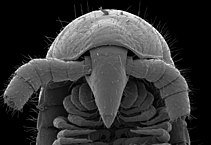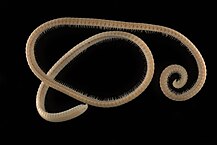Eumillipes
 From Wikipedia the free encyclopedia
From Wikipedia the free encyclopedia
| Eumillipes | |
|---|---|
 | |
| A female with 330 body segments and 1,306 legs | |
| Scientific classification | |
| Domain: | Eukaryota |
| Kingdom: | Animalia |
| Phylum: | Arthropoda |
| Subphylum: | Myriapoda |
| Class: | Diplopoda |
| Order: | Polyzoniida |
| Family: | Siphonotidae |
| Genus: | Eumillipes Marek, 2021[1] |
| Species: | E. persephone |
| Binomial name | |
| Eumillipes persephone Marek, 2021[1] | |
Eumillipes is a genus of millipede in the family Siphonotidae. It contains a single species, E. persephone, known from the Eastern Goldfields of Western Australia. The species was first collected in 2021, discovered in three drill holes, living at depths of between 15 metres (50 ft) and 60 metres (200 ft).[1]
Etymology[edit]
Its generic name, Eumillipes, means "true millipede" (or "true thousand feet"), referring to its possession of over 1,000 legs; its specific name, persephone, alludes to the Greek goddess of the same name, who was the queen of the underworld, in reference to its subterranean lifestyle.[1][2][3]
Description[edit]
First described in 2021, individuals reach up to 95 mm (3.7 in) in length, and about 1 mm (0.039 in) in diameter with 198 to 330 body segments and up to 1,306 legs, making it the species with the most legs on Earth and the first millipede discovered to have 1,000 legs or more.[1][4]
It has a highly elongated body with a cone shaped head and unusually large, thick antennae. It is eyeless, a trait not found in any other Australian polyzoniidan.[1] Its elongated shape, large number of legs, and eyeless condition is convergent with the distantly related Illacme plenipes of North America, the previous record holder with up to 750 legs.[1][5][2] Their 700+ legs, their compressible unfused rings, extensible trunk, and flexible body is able to assist them in squeezing through its underground habitat, enabling it to crawl inside narrow crevices[6] In combination with the many legs, longitudinal and oblique muscles pull the rings together, facilitating forward locomotion.[6]
It varies from most members of Polyzoniida, with its elongated shape and thin body, as members of that order are usually shorter, with fewer legs and flatter dome-shaped bodies. Its inclusion in this order was based on analysis of its genome to determine a common ancestor.[4]
Its diet and lifestyle details are unknown, but it is thought that it may feed on fungi growing on the roots of trees.[4]
Discovery[edit]
E. Persephone were discovered under 60 meters of semiarid desert soil in a resource-rich region of Australia and are imminently threatened by surface mining.[6]
References[edit]
- ^ a b c d e f g Marek, Paul E.; Buzatto, Bruno A.; Shear, William A.; Means, Jackson C.; Black, Dennis G.; Harvey, Mark S.; Rodriguez, Juanita (16 December 2021). "The first true millipede – 1,306 legs long". Scientific Reports. 11 (1): 23126. Bibcode:2021NatSR..1123126M. doi:10.1038/s41598-021-02447-0. PMC 8677783. PMID 34916527. S2CID 245317751.
- ^ a b Preston, Elizabeth (16 December 2021). "At last, a true millipede that actually has 1,000 legs or more". The New York Times. Archived from the original on 16 December 2021. Retrieved 16 December 2021.
- ^ "Millipede with more legs than any known animal discovered in Australia". BBC News. BBC. 16 December 2021. Archived from the original on 17 December 2021. Retrieved 17 December 2021.
- ^ a b c "We have a new world record holder. Introducing the first millipede with more than 1,000 legs - ABC News". amp.abc.net.au. Archived from the original on 2021-12-17. Retrieved 2021-12-18.
- ^ Lu, Donna (16 December 2021). "The first true millipede: New species with more than 1,000 legs discovered in Western Australia". The Guardian. Archived from the original on 16 December 2021. Retrieved 16 December 2021.
- ^ a b c Marek, Paul E. (5 December 2022). "Myriads". Current Biology. Archived from the original on 5 December 2022. Retrieved 5 December 2022.



